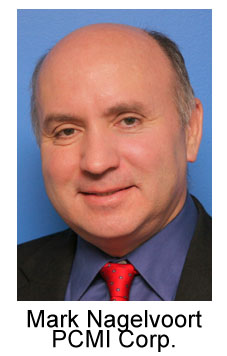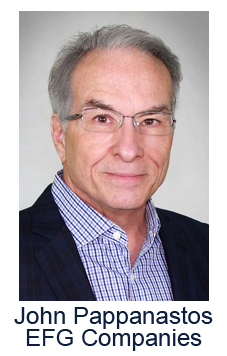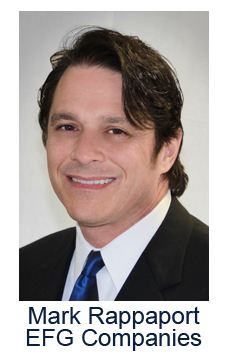VSC Veteran Enters Home Warranty Industry:
Modern claims processing software enables companies in one part of the extended warranty industry to enter another part, despite the differences between them. We spoke with PCMI, the developers of the PCRS platform, and EFG Companies, a warranty administrator and a PCRS user, about the latter's recent expansion from vehicle service contracts to home warranties.
In the extended warranty business, diversifications happen in several directions. Companies in the automotive space are going far beyond mechanical breakdown insurance, broadening the market from break/fix to loan insurance and even unemployment coverage. Companies in the home warranty space are deepening the market into covering not only the pipes outside, but someday perhaps even the theft of delivered packages sitting on the porch. Companies in electronics, appliances, furniture, and other consumer markets are looking to expand the sales channels beyond the brick-and-mortar check-out line.

Mark Nagelvoort, the CEO of PCMI, a longtime sponsor of Warranty Week and a well-known provider of warranty claims processing and administration software, sees more of his customers looking to make the jump — broadening, deepening, and expanding their protection plan offerings whenever and wherever they think it makes business sense.
"The thing we find amazing is that people who purchase extended warranties on their car, they buy them for their home — they buy them for everything," Nagelvoort said. "And I always thought there was a tremendous opportunity to look at them as a holistic customer, and offer them all these products. But it seems the people who design the products and pay the claims — the home warranty group, the consumer warranty group, and the auto warranty group — they tend to be different business units."
No Technical Barriers
Nagelvoort said PCMI's PCRS platform can support all the different types of protection plans — auto, electronics, mobile, appliance, home, etc. "There's absolutely no technical barriers at all," he said.
There are some differences in the front-end screens, he noted, because the questions you have to ask the customer are a little different for each market. "When you go to sell them a car, you just need to know their VIN number and mileage. When you go to sell them home, you need to know what kind of a home, how big of a home. Are you the seller? Are you the buyer? The questions are different. So the interfaces are different. But we pride ourselves on being able to cover every market, so that somebody can treat a customer holistically across multiple segments, if they wanted to."
The thing is, not many want to. Or more precisely, many wish they could, but for business, legal, regulatory, or marketing reasons, they haven't yet done so. But it's coming. Nagelvoort said he sees a very real possibility that some of his platform customers will launch a multi-segment suite of protection plans in the very near future.
One client that's already diversified from vehicle service contracts into home warranties is EFG Companies, a 47-year-old third-party administrator located in Irving, Texas. John Pappanastos, president and CEO of EFG Companies, detailed how the company has expanded from VSCs to other markets in recent years.
"We've built furniture contracts, we've pursued e-bike anti-theft programs, and we're probably best known for an involuntary unemployment program called Hyundai Assurance that was launched during the Great Recession," he said. That program also covers physical disability, mental disability, accidental death, critical illness, international job transfer, loss of driver's license for medical reasons, and lots of other perils that have little to do with automotive break/fix coverage.
Sales vs. Service Network

Five years ago, EFG carefully entered the home warranty industry, making sure not to expand its sales territory too far ahead of its service technician network's reach. Pappanastos said both have to grow in tandem, or else customer satisfaction drops because claims aren't addressed fast enough.
"When we moved into home warranty it was because we have very strong administrative capabilities," Pappanastos said. "We wanted to diversify from vehicle-related products and from dealer distribution only. But the challenge was building a technician network. You have to grow your technician network as you grow your distribution. You can't grow it in advance, because then you're not giving them any volume, and they don't know who you are."
Nagelvoort said there's a nationwide shortage of qualified service technicians, so it's an industry-wide problem. He said the PCRS system can handle both an internal servicer network and contracts with providers of external networks — even both at the same time. But there's not much he can do about the shortage of workers.
"Across America, everybody is having a problem," he said. "Everybody is concerned if there are enough new service techs being trained to replace those who are retiring."
Initially, Pappanastos said, when EFG entered the home warranty line of business five years ago, it outsourced claims administration. And then when the company felt good about its prospects in the business, it decided to bring claims administration in-house and run it on PCMI's PCRS platform.
"And when we did that, we found a 28% reduction in our average claims costs," he said. One way the platform does this is by giving EFG better visibility into early claims emergence. Another is the way that reports can spotlight which contracts are the most unprofitable. "If we've got a distributor that's putting us in bad contracts, their systems give us the data," he said.
"I think 85% of our claims are being handled by our own, in our own network of technician repair shops. Only 15% are not being carried by our own our network."
Differentiation

The home warranty industry is dominated by several large players, such as American Home Shield, that have a multiple-decade head start on new market entrants such as EFG. One way Pappanastos said EFG differentiates itself from some of these larger and more established competitors is the speed at which it pays those service technicians for the work they perform. "They want rapid payment," he said, "and they don't get rapid payment from warranty companies."
In contrast, EFG guarantees them a fast payment within 21 days, or it pays them a 10% penalty. "One of the biggest priorities is to pay the claims to those technicians because if they're getting paid, they're in your game, but if they're not, they don't want to play," Pappanastos said. "So they're really happy to do business with us, because they know they're going to get paid promptly. And if we don't, we owe money."
About four years ago, EFG came to PCMI looking for a home warranty solution to replace a green-screen application they had running on an old IBM AS/400 system. Anju Nair, PCMI's product manager for consumer warranty, said she was hired around the same time as EFG began implementing the new PCMI system. "At that time," she said, "they'd been selling home warranties for a few years, and they wanted to expand."
EFG already had a service network in place for the areas in which they were selling home warranties, and PCMI added these into its dispatch system, setting up some rules in the meantime. Some servicers were marked as preferred while others were marked as restricted. Some were listed for specific product categories, and some were limited to just certain manufacturers' products. Some were listed just for specific Zip Codes. But that rulemaking was all left up to EFG to decide.
"And then, based on the rules that were configured, the right set of servicers would show up for every claim," Nair said. The customer contacts EFG's call center, their entitlement to a repair service is verified, and a servicer that covers that product in that geography is assigned to the claim. The assigned servicer would then contact the consumer to arrange an appointment for a house-call.
Servicers can be ranked by both EFG and by consumers based on customer satisfaction surveys, and these rankings can be added into the screens that allow dispatchers to choose among several servicers qualified for a given product repair in a given geography.
Careful Startup

Mark Rappaport, president of EFG's Diversified Solutions Division, also recalls how EFG carefully entered the home warranty business. "At that time, we had outsourced our claims adjudication process for home warranty," he recalled. "We'd been in the business for maybe three years prior to that, but we wanted to monitor everything to make sure we were delivering a good quality experience."
Then, once EFG decided this was a viable business worth pursuing for the long term, it decided to bring the claims adjudication process in-house. And it decided to move onto PCMI's PCRS platform.
"PCMI was chosen because of its robustness, because of its scalability, and because of its background in the marketplace — doing work with a large number of other administrators on both the VSC side and the home warranty side," Rappaport said. "And more importantly, their product feature set really supported our needs in the claims adjudication process."
"If you were using a homegrown system that was adapted just to vehicles, and perhaps even just to break/fix and mechanical breakdown, it probably would have been an impossibility to do this kind of diversification," Rappaport said. "Without PCMI we would have had to develop it all internally. But I would have never wanted to build a proprietary system."
Pappanastos said the home warranty program has been very successful, for several reasons. First, he said, the loss ratios are better, and they're more predictable than on the auto side. Second, the appeal across the country to the customer is better. And third, he said, "We have a great partner with PCMI and I think that relationship has gone swimmingly. It's an effortless relationship to work with those guys, and we've been very pleased with them."
"One of the major reasons PCMI has been so successful is we have a tremendous R&D process of continuous innovation," Nagelvoort said. "We actually have four major releases a year, with minor releases between the quarters. We have a substantial number of upgrades, and continuous development. We now have 200 people in the company working just on the admin system. So I think one of the big things is the amount of investment you need to do is so much higher today than what they were just five years ago."
Nagelvoort said his current clients seem to want more help with add-ons such as a website for the consumers to use while they're considering a purchase, or a portal for the servicers to use while they're working on a claim. And they want websites that can be accessed from a phone as well as from a computer. "The expectations keep going up; they're not going down in terms of accessibility."
Service Delivery Differences
Nair said lately she's seen some other PCMI clients also begin to make some initial moves to expand from the auto side of the business into the appliance, electronics, and home warranty side of the business. PCMI's administration platform can handle both sides. But there are some very important differences between them.
For instance, there is the way that repairs are delivered. A car would typically be driven or towed to the repair shop. A refrigerator or a central air conditioning unit would be repaired on-site. A toaster or a clock radio might not be repaired at all — instead, a replacement unit might be shipped to the consumer.
"The way the platform is designed, it can support multiple kinds of products," Nair said. "We support home warranties. We support OEMs. We support furniture protection plans. We support cellphone protection plans. That's how the core system is designed — so that our customers can add new products. It's technically possible. Configuration-wise, how complicated it's going to get depends on the requirements of the client."
She said the core architecture of the system allows many minor changes to be done without the need for software developers to get involved. "You just do it on the screen." Complicated changes will need help from developers, but even then, they can usually just build them over the core system.
Nair sees a wide opening for additional innovations on the consumer side of the protection business, delving into areas that have absolutely nothing to do with product failure or repair. For instance, she sees a need for "shipping protection," which would compensate a consumer if their packages are stolen off the front porch.
Another big difference for home warranties, is the addition of a deductible — a service fee of $40 or $50 that the consumer has to pay to the servicer when they arrive for the repair. EFG frequently uses a payment gateway service called Authorize.net, a subsidiary of Visa, to help them collect these deductible payments from their customers before a technician is dispatched to the home, and PCMI has integrated with that service.
Adverse Selection
EFG sells home warranty contracts that are priced as a base plan, with surcharges for each selected add-on. Prices can be different in each state, reflecting the expected claims cost. In all, the company sells some 200 different permutations.
"We can show them out of those 200 plans, which plans have the highest loss ratios, and which plans have the lowest loss ratios," Nair said. PCMI can also show the client which selling dealer, or which call center, has the highest and lowest loss ratios on the plans they sold.
Nair said that adding or changing coverages is fairly straightforward from a technical point of view. But for business reasons, particularly worries about adverse selection, coverages can only be changed right after the initial sign-up, or around the time of an annual renewal.
Rappaport said adverse selection is a major concern for home warranty providers. "Usually, when somebody calls and wants to add a feature halfway through the contract, they've got a problem. So we do our best to avoid adverse selection," he said. "But in any consumer group there are people who like to take advantage of the processes and know how to use it to their advantage.
"We're insuring a large group of consumers based on the fact that they're going to honor their agreements, in the correct format, in good faith. But there are a small group of consumers that prefer to utilize the contract in not-so-good faith," he added.
Nagelvoort said initially it was a challenge to engineer an admin platform that would allow clients to offer all these different sorts of options for coverage. Now it's a question for those clients as to whether they should offer all those options and permutations.
"I'm thrilled that we've been able to eliminate it from a technical problem — that we can't do it — to should we do it?" Similarly, there are no technical hurdles to changing the range of coverages in the middle of a policy period. But there's always the potential that the consumer is trying to get the added coverage now so that a unit that broke but wasn't previously covered can now be fixed for free.
"It's definitely not a technical issue," he said. "But there is a concern that the adverse selection will be higher. That's one of the reasons we do it only at renewals.
"I think we all do the same with our health care coverage at work. You have to enroll for coverage. Do you want the dental plan? We have enrollment periods. And I think we found from a business standpoint that people look at the issuance the same way."
Top Markets
Like many home warranty providers, EFG's best markets are in southern states such as Texas, Arizona, Louisiana, and Florida. "We do well on the East Coast and West Coast as well," Rappaport said, "but most of the volume is coming in the Mid Central and South Central parts of the United States." That's somewhat different from the geographic spread of EFG's vehicle service contract business, which is much more evenly spread across all the states.
Of course, existing homes are also spread much more evenly across the country. So what makes home warranties so much more appealing in the South? Rappaport said it may simply be the fact that the relative success of its home warranty sales in the South makes the company's sales force focus more on that area. Or, it may be the fact that this is where the sun is strong and central air conditioning is almost mandatory, and a prompt repair of it is almost compulsory.
It's a bit different from the family car, Rappaport said. "A customer needs a car to get to work, to pick up groceries, to pick up kids, to get to school, and so forth. But the home is more critical because they spend more time in the home than they do in the car," he said.
"When something goes out in the car, often times you can offset it with a taxi, with a friend getting you to work, or sharing a ride. But when a home goes out, everybody has a problem, because if your air conditioner's out, everybody sweats," he said. "It's not just one person. You can't go to another home. You can't let the repair slide for a while.
"So homes have a much more prominent fixation by the consumer to be able to take care of their needs because they live in their home. They live in it more — they have more hours in their home than they do in their car, and they can't just temporarily move to another home for a time until it gets fixed.
"So the demand for home warranty claims, while it's just as impactful for vehicle service contracts, it's more important to the consumer that somebody be there as quickly as possible and get it fixed as quickly as possible, especially when it's 99 degrees outside, or in the other case, 11 degrees outside, and you can't get your heat on," Rappaport said.
Climate change has already begun to impact the home warranty business. This past summer, top markets in states such as Arizona and Texas broke records for not only highest daytime temperatures, but also for highest night-time temperatures. And it went on for months.
"We've seen heatwaves come across America that we thought were unprecedented," Nagelvoort said. "I think the demand for this product is higher than it's ever been. Most people never thought their air conditioners would be supporting a hundred degrees for seven days in a row. And I think that the need for home warranties has increased with the climate change issues. So we think these products make more sense for consumers now more than ever."








